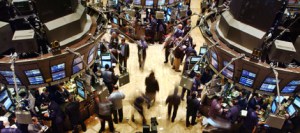
January 9, 2018 | Daily JAM, Morning Briefing, NKTR, Stock Alerts |
Anybody still think that conferences, especially biotech conferences, don’t move stock prices? Shares of Nektar Therapeutics (NKTR) are up 7.65% today to $61.79 as of noon New York time on the company’s appearance at this week’s J.P. Morgan biotech conference. The slides from the company’s presentation today are in circulation but CEO Howard Robin doesn’t actually present until 2 p.m. New York time today.

January 2, 2018 | Daily JAM, FQVLF, Stock Alerts |
When, way back on August 17, I started recommending going long copper on the increasing adoption of electric cars, I noted that the big uncertainty in this play was how fast demand for electric vehicles and charging stations would grow. Electric cars use more copper...

December 18, 2017 | Daily JAM, NKTR, Stock Alerts |
No point in hoping that Nektar Therapeutics (NKTR) will match this year's gain of 364% as of the close on December 18. But I think the stock could easily climb another 30% or more in 2018 as the company de-risks its very promising drug candidates in the opioid and...

November 30, 2017 | ARGT, Daily JAM, GGAL, Volatility |
Yesterday Moody’s Investors Service raised Argentina’s credit rating one level to B2 from B3. I added Grupo Financiero Galicia (GGAL) and Global X MSCI Argentina ETF (ARGT) to my Volatility Portfolio on my expectation that President Mauricio Macri’s macroeconomic reforms would gradually revive the economy and lead to upgrades in the country’s credit rating (and a drop in runaway inflation.) The two picks are up 69.12% and 7.29%, respectively, since I added them to this portfolio. Argentina is on track, Moody’s said in its upgrade, to turn in two years of economic growth in a row in 2017 and 2108, which would be the first time that’s happened since 2011. Moody’s projects that the Argentine economy will grow by 3% this year and 3.5% in 2018.

November 13, 2017 | Daily JAM, MGM, Stock Alerts |
On November 8 MGM Resorts International (MGM) reported third quarter earnings of 33 cents a share. That was a penny below Wall Street estimates. Revenue climbed 12.3% year over year to $2.83 billion, above analyst projections by $70 million. Revenue from the company's...

November 13, 2017 | Daily JAM, NKTR, Stock Alerts |
To subscribe to JAM you need to fill in some details below including, ahem, some info on how you'll pay us. A subscription is $199 (although if you're subscribing with one of our special offers it will be lower) for a year for ongoing and continuing access to the...

November 13, 2017 | Daily JAM, NKTR, Stock Alerts, Volatility |
Shares of Nektar Therapeutics (NKTR) are up another 16% this morning to $37.89 as of noon New York time on data presented this weekend at the annual meeting of the Society for Immunotherapy of Cancer from an early trial of Nektar's NKTR-214. The data looked at the...

November 9, 2017 | Daily JAM, NKTR, Stock Alerts, Volatility |
On the evening of October 31 I wrote that a decision onwhat to do with the Netkar Therapeutics options (NKTR180119C00022000)--the January 19, 2018 call at $22--that I added to my Volatility Portfolio back on May 16, 2017 at a price of $2.64 (the closing options price...

November 8, 2017 | Daily JAM, Uncategorized |
You don’t have to do anything now–but come January 2018, if 2017 finishes the way I outlined in my last post on this momentum market and end of the year selling/window dressing I think rebalancing a portfolio will be a very smart way to begin 2018. Rebalancing–selling winning positions and adding to losing positions until all the holdings in a portfolio are equally weighted–will automatically take profits in the biggest winners of 2017 and redistribute some of that cash into stocks that have been sold down in 2017 but that look set to rebound in 2018.

October 31, 2017 | Daily JAM, Perfect Five-ETFs |
I’ve named the five ETFs in this portfolio. Explained my ideas on allocation money among those five ETFs and their associated asset classes. And discussed the importance of knowing what index an ETF follows. Now it’s time to explain one last thing to complete the set up of this new portfolio: Why I’ve positioned it next to my Volatility Portfolio on JugglingWithKnives.com and JubakAM.com.

October 26, 2017 | Daily JAM, EWZS, Volatility |
Brazil’s President Michel Temer has once again escaped a trial for corruption after an effort to send charges against Temer to the Supreme Court failed to get the necessary 2/3 majority in Congress required before a sitting president can be forced to stand trial.

October 10, 2017 | Daily JAM, EWZS, Stock Alerts |
The political turmoil is by no means over and with embattled President Michel Temer facing another vote in Congress over whether he will stand trial for corruption, there's likely to be at least one more round of fiscally irresponsible vote-buying outlays by the...











